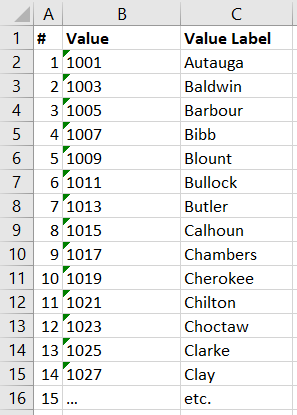
#Spss code book for excel software
11.Home > Software > SPSS > Importing Databases Also, classify items with values that range from Strongly Agree to Strongly Disagree as Ordinal. NOTE: To maintain consistency, classify items with values Yes and No as Scale. Select the type that is most appropriate. Click on the grey box encircled on the diagram on the left. Click the cell under the Measure column for the corresponding variable. Finally variables that are classified as Scale are those that include answers which fall on a continuous range. For example, the questions, What is your income? followed by the answers, $0-$10,000 $10,000-$20,000 $20,000-$30,000 would be classified as Ordinal. These are variables that have answers that have a scale of measurement in which data are arranged in rank order. A variable can also be classified as Ordinal. For example, the question What occupation do you have? followed by the answer choices Doctor, Lawyer, Engineer, would be classified as Nominal. Each variable has three possible designations: i. For each variable, you ll assign the kind of Measure each is. For columns Columns and Align, you won t have to adjust any information. Next, enter the values that the computer should ignore during data analysis. On the Missing Values box, select Discrete missing values. Then click the grey box encircled on the left diagram. Click on the cell under Missing for the corresponding variable. If listed within the questionnaire item, you ll also be entering values that signify Don t Know under this column. In almost all cases, you ll be entering 99 (or other values that signify missing) under this column. Otherwise, the obtained average will be wrong.) i. If the average age is being calculated, you would want the computer to ignore missing values that are coded as 99. Under column seven, Missing, you ll be entering values that the computer should ignore during data analysis. Once all values have been entered, click OK.

Accordingly, you may have to enter the values for questionnaire items that have coded for Don t Know. If the value for Missing values is included within the questionnaire you re working from, use that value. This value is usually coded by 99 or 999. For each questionnaire item, you will have to enter an item that codes for Missing values. Repeat and enter all remaining questionnaire item answers. In case of variable Gender, you may enter 1 and Male. Under the Value field, enter a number and under Label enter the corresponding label. This is where you ll be entering the values for the variable. Then click on the grey block encircled on the diagram to the left. Click on the Values cell for the respective variable. These values are used when entering and analyzing data. These numbers will be used and entered into this column. Within the questionnaires you ll be coding from, most answers to items are assigned a number. For (almost) all variables, you ll enter a set of Values into the sixth column. To enter the label, just double click on the cell and type in. Again, keep in mind that the person who may be doing data analysis may not have access to the actual questionnaire as a reference. The description should provide a clear understanding of what the variable is about.
The fifth column Label includes a description of the variable. For columns Width and Decimals, you won t have to adjust any information. The Variable Type box will appear on the screen. First click the cell next to the variable name and click in the gray box (which appears encircled in the diagram on the left). (Most of the items within the code book will be classified as Numeric. You ll pick Numeric when the questionnaire item is closed-ended. The variable id would be classified as String. You ll pick String when the questionnaire item is open-ended.

Most often, in the second column Type, you ll assign each variable as being either String or Numeric. This identifies each questionnaire that is entered. The first variable in every code book is id. Keep in mind that the person who may be doing data analysis may not have access to the actual questionnaire as a reference. Try to make sure that the variable name you create gives as much information about the questionnaire item as possible. The variable name is limited to 8 characters. In the first column Name, you ll be assigning unique variable name to each item within the questionnaire you re working from. This is where you ll begin to construct the code book. When you begin, make sure you re in the Variable View. The icon will probably look something like this 2. 1 A Quick Guide to Constructing an SPSS Code Book Prepared by Amina Jabbar, Centre for Research on Inner City Health 1.


 0 kommentar(er)
0 kommentar(er)
